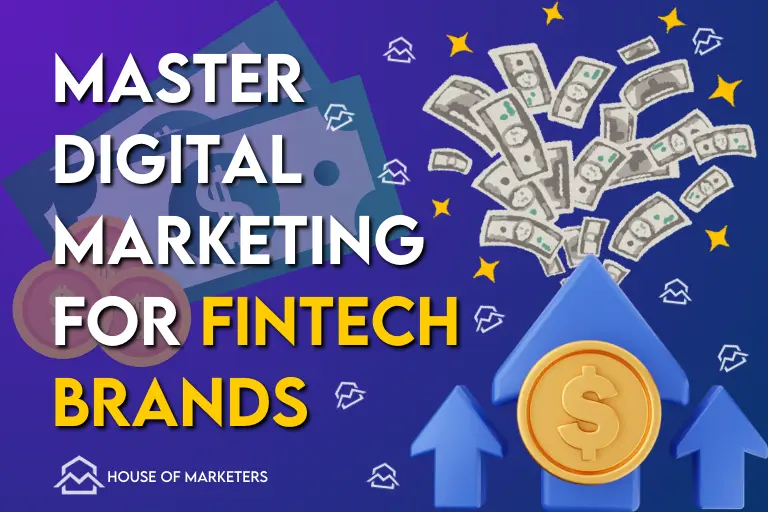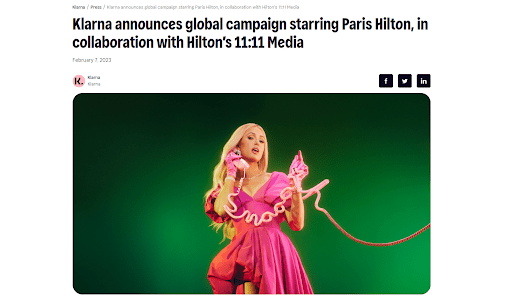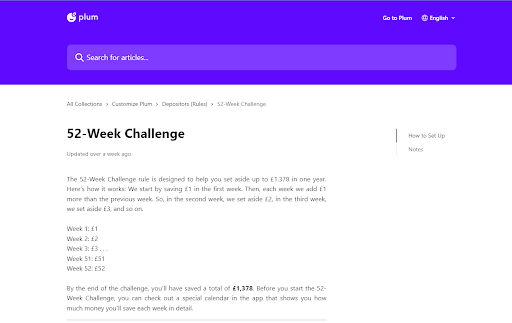
The FinTech industry, valued at approximately $226.76 billion, has experienced explosive growth, nearly doubling its global revenue since 2017. FinTech companies now account for about 5% of the global banking sector’s net revenue, with projections suggesting this share will grow significantly in the coming years.
Amidst this growth, the intersection of technology and finance presents unique marketing challenges, but also unprecedented opportunities. This guide from House of Marketers dives deep into 12 cutting-edge digital marketing strategies tailored for the FinTech sector. Here, we are talking about proven methodologies and tactics that not only resonate with a digitally native audience of millennials and Generation Z but also convert engagement into sustained revenue.
By the end of this article, you will gain insights into creating effective digital campaigns and learn why contacting a specialised TikTok marketing agency could be the next step in scaling your FinTech brand.
What Is a Fintech Marketing Strategy?
For a FinTech brand, your marketing strategy should combine advanced analytics, targeted customer segmentation, and multi-channel digital campaigns to effectively engage with current and potential customers.
In simple terms, the goal of your FinTech marketing strategy should be to reach and convert potential users into loyal customers. Despite the innovative nature of your FinTech product, grabbing the attention of your target audience and sustaining their interest is challenging.
No matter how useful your product may be, finance is often perceived as a dry or daunting subject, filled with complexity that can deter engagement and even user-acquisition.
To effectively capture and maintain your audience’s interest, your approach must be thoughtful and nuanced. It’s not enough to present your FinTech solution, you also need to make it accessible, engaging, and, most importantly, helpful. This is where digital marketing comes in.
12 Ways to Effectively Leverage Digital Marketing For FinTech Brands
“Organizations that are not aligned with millennial and Gen-Z values risk losing favor with this large and increasingly influential cohort,” Michele Parmelee, Deloitte Global Deputy CEO and Chief People & Purpose Officer. (Source: Forbes)
Here’s how you can leverage digital marketing to find your audience online.
1. Utilise Short-Form Content Platforms like TikTok
Platforms like TikTok offer a golden opportunity for FinTech companies to engage with younger demographics. These demographics are increasingly seeking financial literacy, with research by Experian indicating that 77% are eager to enhance their understanding of personal finance.
A robust strategy on TikTok involves content that educates, entertains, and establishes trust. Post a mix of educational content that simplifies complex financial concepts, customer testimonials that build trust, and behind-the-scenes glimpses into the technology or people behind the services.
Start by identifying common financial misconceptions among your target audience and create short, engaging videos that address these topics in a clear and accessible manner.
2. Partner with Influencers to Expand your Reach

Source: Klarna
Partnering with influencers who already have the trust of your target audience can be a game-changer. These influencers can simplify financial content and make your services appear more accessible and user-friendly. Choose influencers whose followers mirror your target demographic and who share values similar to your brand.
An example of successful influencer partnership in the FinTech industry is Klarna’s ‘That’s Smooth’ campaign featuring Paris Hilton. This campaign cleverly leveraged Hilton’s iconic persona to redefine ‘smooth’ shopping experiences, making Klarna resonate with a broad audience seeking hassle-free and stylish payment solutions. The partnership not only amplified Klarna’s brand visibility but also showcased its commitment to providing seamless and fashionable shopping experiences, aligning perfectly with the lifestyle of its target users.
For more in-depth analysis and examples of Successful Fintech Marketing Campaigns check out our guide.
3. Continuous Adaptation
Monzo, a British online bank based in London, uses real-time analytics to gauge the effectiveness of their Twitter campaigns, quickly adapting their strategy in response to trends in customer engagement and feedback.
FinTech brands must continuously analyse the performance of their content to refine their strategies. All digital marketing platforms provide detailed analytics that can help you understand what types of videos gain the most traction, the best times to post, and viewer demographics. This data is invaluable for optimising future content and increasing ROI. Utilise this data to adapt and improve your campaigns and content.
Data is a goldmine for FinTech companies. Use analytics to track user behaviour across all digital platforms, understand what content works, identify trends, and predict future behaviour. This insight helps to craft more effective marketing strategies.
4. Instagram and YouTube for Visual Storytelling
Instagram and YouTube are powerful platforms for FinTech brands to dive deeper into their offerings with visually engaging content. For instance, Instagram Stories and reels can be used for quick tutorials on app features, while YouTube is ideal for in-depth product demos and customer success stories. The visual element helps demystify complex financial services, making them more accessible.
5. Utilise LinkedIn for B2B Connections
LinkedIn is indispensable for B2B-oriented FinTech companies. It’s a platform where you can establish thought leadership through articles on industry trends, insights, and innovations. Participating in relevant groups and discussions also helps build credibility and network with potential business clients and partners.
Quick updates about market changes, regulatory news, or software updates keep your audience informed and engaged. It’s also an excellent medium for customer service, providing quick responses to user queries.
6. Create Engaging Challenges Online

Source: Plum
Plum, a FinTech App, set a remarkable example with its 52-week savings challenge launched on TikTok. By collaborating with finance influencers, Plum not only tapped into a dedicated community of financial enthusiasts but also made saving money a fun and engaging journey for its users. This approach utilised the viral nature of TikTok to motivate users to start saving, turning the daunting task of financial management into an exciting and socially interactive experience. The campaign’s success highlights the effectiveness of combining educational content with influencer outreach to foster a positive financial habit among younger demographics.
Users enjoy creative and useful challenges. If your app offers a solution, create a challenge around it for high-engagement content. Incorporating popular trends, challenges, and features like polls or live streams can increase visibility and interaction. For example, launching a challenge that encourages users to share their personal saving goals or financial wins can create a community feeling and boost engagement.
7. Implement SEO Strategies For Organic Marketing
For FinTech companies, being visible on search engines can significantly enhance credibility and attract new customers. Keywords should focus on specific financial services and solutions, addressing common customer pain points and queries. Technical SEO and local SEO are also vital to ensure your website is fast, mobile-friendly, and geographically targeted.
Perform keyword research to identify what potential customers are searching for related to your services. Use tools like Ahrefs or SEMrush to discover high-volume, low-competition keywords. Optimise your website’s content, titles, and meta descriptions to incorporate these keywords.
8. Use Content Marketing for Organic SEO

Source: WealthSimple Magazine
High-quality, informative content that addresses the needs and questions of your audience can establish your brand as a trustworthy authority in the FinTech space. Regular blogs, whitepapers, and e-books not only attract organic traffic but also engage and educate potential customers, nurturing them through the sales funnel.
Although nowadays content is everywhere and everyone seems to be a writer, content marketing remains one of the most powerful and cost-effective fintech marketing tactics out there. A rightly implemented content marketing strategy can not only boost a company’s organic traffic and SEO (which has become “a must” in today’s digital-first world) but also establish its brand as a thought leader and expert in its field. This will further help grow consumer confidence and gain trust.
Canadian investment app startup, Wealthsimple, serves as a prime example of a fintech company excelling in content marketing and storytelling.
The market is flooded with generic ‘tips and tricks’ and ‘top five things to know’ content, driving a demand for deeper, more substantial articles featuring real-world examples and case studies of successful and unsuccessful strategies. Aligning with this shift, Wealthsimple has crafted distinctive and sharp editorials that connect more with their audience’s interests rather than just their technology.
Notably, their Money Diaries series includes interviews with well-known figures like Anthony Bourdain and Kevin Bacon, as well as everyday individuals. These stories delve into how people from diverse backgrounds address their financial challenges within the broader narrative of their lives, careers, and personal ambitions.
9. Make Use of Email Marketing and Personalisation
Segment your audience based on their behaviour, needs, and interaction with your site. Personalised emails that cater to these segments can significantly increase engagement rates. For example, sending customised advice on financial planning to users who have shown interest in savings accounts.
Email marketing automation tools can help schedule and execute campaigns more efficiently, ensuring consistent communication. These tools also provide valuable analytics to refine your strategy, like open rates and conversion tracking.
10. Privacy and Security
Given the sensitive nature of financial data, ensuring that your digital marketing practices comply with global data protection regulations (like GDPR and CCPA) is essential. Transparency about how you handle data builds trust among users.
11. Paid Advertising Strategies
Pay-per-click campaigns on platforms like Google Ads and social media can drive significant traffic to FinTech websites. Use well-researched keywords, compelling ad copy, and strong calls-to-action. Retargeting ads can also remind users who visited your site but didn’t convert to come back and complete their actions.
Implementing sophisticated retargeting strategies can help convert users who have shown interest but haven’t yet committed. For instance, targeting them with specific offers or reminding them of the benefits of your financial service can increase conversion rates.
12. Localising Content for Global Markets

Source: Wise
Understanding and respecting cultural differences is crucial when expanding globally. Customise your marketing messages to align with local customs, financial habits, and preferences, which enhances receptivity and engagement.
Offering your content in local languages can significantly boost engagement and trust. Ensure translations are not only linguistically correct but also culturally appropriate.
One standout example of effective localization in FinTech is Wise, a company that has set a benchmark for multilingual support. Catering to a diverse global audience, Wise offers its financial services across numerous languages, including Turkish, demonstrating a tailored approach to meet the specific needs of each market. By providing a user interface and customer support in the native languages of its customers, Wise ensures that users can manage and transfer money with ease and confidence, regardless of their primary language. This commitment to accessibility significantly enhances user engagement and satisfaction, making Wise a preferred choice for international money transfers.
Key Elements of Effective Fintech Marketing Strategy
FinTech customers range from tech-savvy millennials seeking the latest in mobile banking to older generations looking for secure and simple ways to manage their finances online.
Effective digital marketing strategies arise from a deep understanding of these demographic and psychographic profiles—including factors like age, location, technology usage, financial income, and personal preferences. This understanding helps in crafting messages that resonate, engage, and convert.
For instance, younger audiences may prefer quick, informative videos on TikTok or Instagram, while older clients might appreciate more detailed articles or emails that provide thorough explanations and reassurances about security features.
- Consistency and Security – Your marketing efforts must emphasise the consistency and security of your app. In a domain as sensitive as finance, trust is paramount. Your audience needs to know that they can rely on your app not just for its functionality but also for its security features.
- Empathy and Understanding – Demonstrating a deep understanding of the challenges your audience faces is crucial. Your content and messaging should resonate with their experiences and offer genuine solutions to their specific financial pains.
- Accessibility and Engagement – Meet your customers where they are. This means adapting your strategies to suit their behaviours and preferences, which is where TikTok comes in. The platform offers a unique way to engage with users through formats that are native to their daily social media consumption habits.
- Differentiation – The digital landscape is crowded with FinTech solutions. Distinguishing your brand from others is essential. Highlight what makes your app unique, whether it’s an innovative feature, superior user experience, or exceptional customer service.
When your audience is online, your marketing efforts should match that as well. A well-crafted marketing strategy can harness growth, turning potential into profits and engagement into loyalty. In this article, we covered some of the most effective strategies that FinTech brands can use to optimise their digital marketing efforts. From mastering TikTok’s dynamic environment to leveraging traditional SEO and localised content, the digital marketing landscape offers numerous opportunities for growth and customer engagement.
To further explore how FinTech can revolutionise brand growth, read more about The Power of #FinTok in Growing Your Brand.
Ready to Supercharge Your FinTech Brand with House of Marketers?
Whether you’re looking to captivate millennials or streamline customer acquisition, our strategies are designed to propel your brand to new heights. Reach out to us for free consultation about your FinTech Brand.

House of Marketers (HOM) is a leading TikTok Marketing Agency. Our global agency was built by early TikTok Employees & TikTok Partners, which gives us the insider knowledge to help leading brands, like Redbull, Playtika, Badoo, and HelloFresh win on TikTok. Want us to convert more of Gen Z and Millennials with TikTok? Get in touch with our friendly team, here.